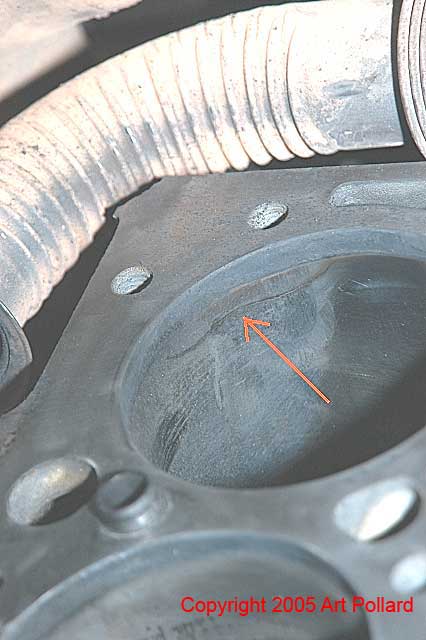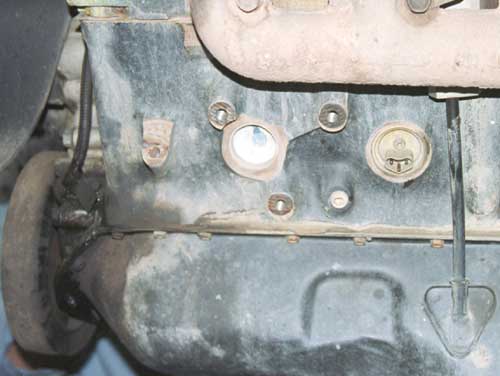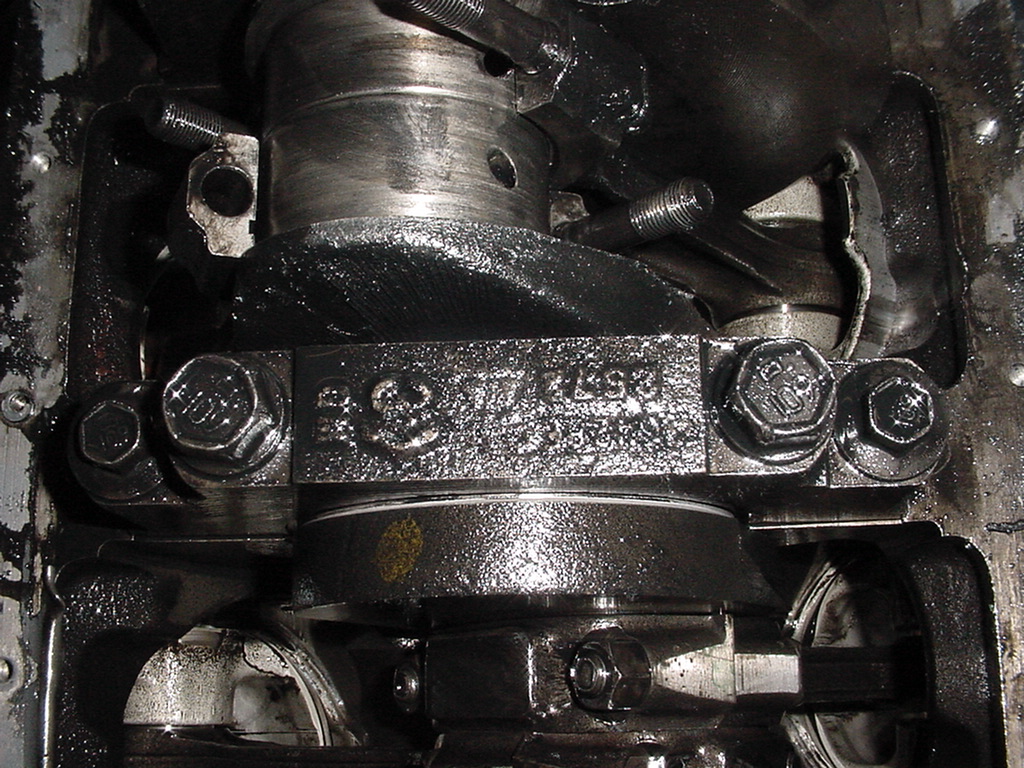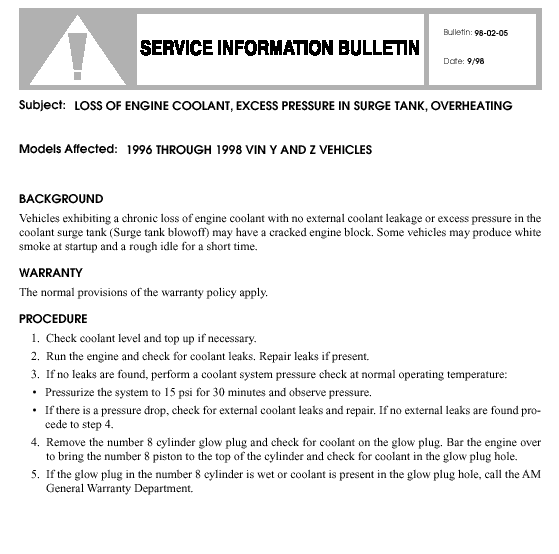Cracked Block Problems in GM Turbo Diesels
Updated June 19, 2018
 Turbo diesels produced from 1996 (when they were first offered on the Hummer) to some say into 2000 are at risk. One of the largest Hummer Dealers says "Most #8 cylinder cracks are appearing on '96 through early '99 Turbo Diesels (we seem to see more '97's and '98's). The engine block was updated in May of '99' before AMG officially took over production". Because there was an existing inventory of engines in the system, Hummers built after the update may not have the enhanced block. There have been some older engines in 2001's.
Turbo diesels produced from 1996 (when they were first offered on the Hummer) to some say into 2000 are at risk. One of the largest Hummer Dealers says "Most #8 cylinder cracks are appearing on '96 through early '99 Turbo Diesels (we seem to see more '97's and '98's). The engine block was updated in May of '99' before AMG officially took over production". Because there was an existing inventory of engines in the system, Hummers built after the update may not have the enhanced block. There have been some older engines in 2001's.
Where is this unlucky cylinder located? It's in the rear on the passenger side of the truck. As of June 2004 a very good price for an engine replacement at a dealer is $13K with $10.5K for an engine, $2.2K labor, and $0.3K for other parts, coolant, etc.
AMG does not have a foundry. The block is cast by International Harvester for General Engine Products ( AM General ) Their logo is in the valley of the blocks.
If the 4th character in your VIN number is a 'Z' your engine was manufactured by GM and is potentially at risk. If the 4th character of your VIN is an F your engine was manufactured by AMG and is the newer design so you don't have to worry. According to sources at AMG, 2000 model year trucks built after VIN # 137ZA9037YE188469 are not at risk.
 There are 2 casting numbers on the block. One casting number can be found under the cylinder head on the passenger side of the engine block. The other number is on the drivers side behind the head partially hidden by the turbo. The numbers are impossible to see without removing the engine cover. The casting number is the definitive way to know if your engine is the newer design.
There are 2 casting numbers on the block. One casting number can be found under the cylinder head on the passenger side of the engine block. The other number is on the drivers side behind the head partially hidden by the turbo. The numbers are impossible to see without removing the engine cover. The casting number is the definitive way to know if your engine is the newer design.
The casting number on the passenger side will tell you the date the block was made. An H121 is:
H = August the 8th month
12 = Day of the month
1 = Year 2001
GM made the # 8 casting changes on engines starting with casting # C-159 (March 15, 1999). AMG waited to purchase these new engines until engines starting with E-019 (May 1st, 1999). C-159 and later engines are the enhanced version. It seems that there are some engines with numbers between C-159 and E-019. These must have been replacement engines that AMG received from GM.
The first enhancement was made to the "Z" engine so many trucks with the "Z" designation have an enhanced block.
The story is that GM's block design had a flaw in the way the head bolts in the Number 8 cylinder area went into the block. Stress was created that eventually caused the block to crack in some engines. There is an area on the #8 cylinder wall where a hole is tapped for the head bolt. The cylinder wall is thicker in that area. The crack was occurring where the wall was thinner, on the opposite end. The engineers decided to extend that thicker portion further down the cylinder wall, to help alleviate the problem.
Supposedly GM fixed the problem and started to produce good blocks in 1999 right before AMG took over the production of 6.5 diesels from GM.
Just an aside; GM sold the 6.5 diesel production and plant to AMG because GM in a joint venture with Isuzu is using the new Duramax direct injection diesel in all it's light diesel trucks. It may be that by June of 2000 AMG was producing good blocks in it's plant although many of the older blocks were already in inventory waiting to be installed in trucks.
The photos below show what I've been told are some of the differences in the blocks. It's hard to see on an installed engine because the motor mounts and starter block your view. Remember, the casting number is the definitive way to know if your engine is the newer design.
How to Tell if your Block is Cracked
The earliest symptom is compression pressure in the coolant. With your truck dead cold after sitting all night open the radiator cap to make sure there is no pressure in the system (there shouldn't be). Put the cap back on and run the engine for 60 seconds. Shut the engine off and remove the cap. If you find that there is pressure in the system (you hear air escaping) there is a good chance that you have a leak between the cooling system and the combustion chamber. This could be anything from a head gasket to a cracked block. The crack will be open when the engine is cold. As the engine warms up the block expands and closes the crack. What happens is high pressure exhaust gas from the cylinder forces it's way through the crack into the water jacket around the cylinder pressurizing the cooling system.
There is a kit that detects exhaust gas in the antifreeze for gasoline engines. I don't know if they work for diesels. They are called block testers, also known as a combustion leak tester. A combustion test kit can be found at your local NAPA, auto parts store. The part number is 700-1006. The price for this part is less than $50.00. Exhaust gases in your cooling system can suggest a head gasket leak, a cracked block, or a warped head.
My 98 engine ran like a top even though it was cracked. As the problem progresses you can do the following. With the engine running and hot, crack open the brass air bleed on top of the thermostat housing. If you consistently get foam coming out your block is probably cracked. This is caused by combustion gas leaking through the crack into the antifreeze and foaming it up. As things get worse you will start to loose coolant, the low coolant light will come on and the engine will start to run hot.
Just a note. Your problem could be a leaky radiator or heater core. Air has been known to get sucked into a leaky radiator or heater core when the cooling system cools down. This will cause foam in the surge tank when the engine is running. You may also want to check your heater control valve, they are notorious for leaking.
Check the exhaust. If it is puffing out white smoke this would be an indication of water in the combustion chamber which points to a major problem. Black exhaust is unburnt fuel or oil which can be normal or depending on the amount and conditions.
A normal running engine has a 195 degree thermostat. It should run with the temperature gauge a little to the left of 200 once it's warmed up. Don't be alarmed if your gauge isn't reading exact. The gauges used in the Hummer are not that accurate. With a cracked engine (in it's advanced stage) the temp will fluctuate up and down and you will be loosing coolant. Check the CDR valve which is the big round gold unit on top of the engine. Pull it out and see if there is a milky white sludge in it. This will be the sign of an oil and antifreeze mixture. When the vehicle is first started you see the white smoke and than it clears because the coolant leaked in at the engines last cool down.
Note that the above symptoms could also be a blown head gasket which is another problem this engine is well known for. You can't tell for sure if #8 cylinder is cracked by doing a compression test. I've been told that the only
sure way to know is to put the cooling system under
pressure when the vehicle is warm and remove the #8 glow plug and rotate the piston to bottom dead center and look for a mist of
coolant from the glow-plug hole. If the engine is cold the metal cylinder wall shrinks and will expose the leak. I would do the test when the engine is cold because in my opinion the crack closes when the engine heats up and expands. The only way to know for sure is to pull the head.
Another easy test for the #8 cylinder is to pressurize the cooling system with a radiator pressure tester to around 15psi. Remove the #8 glow plug and put your hand or a piece of paper in front of it and have someone crank the engine. If coolant sprays out on your hand you definitely have a #8 problem.
Trucks under factory warranty have received a brand new complete engine. At one time the factory was covering engines up to 50,000 miles. I was told by a dealer at Hummer Homecoming 2002 that as of the summer of 2002 AMG only replaces engines in trucks that are still within the standard 3 year 36,000 mile warranty because GM will no longer reimburse AMG for defective engines.
Engines will fail for other reasons then a Cracked Block.
The second most common problem is blown head gaskets. I'm sure many engines that have been diagnosed as having cracked blocks probably had blown head gaskets. Below shows a hot spot on the inside of the #8 cylinder.
One of my forum members wrote this:
My 1998 6.5L Turbo Diesel w/ 67,000 miles blew a head gasket recently, between the #6 and #8 cylinders. I was driving home when it happened. The coolant temperature, which normally runs at 191 F exactly while driving 50-55 mph, spiked up to 228 F or so, for about 5-10 seconds. I get my reading from my ScanGauge II, not the factory gauge. The coolant temperature then dropped rapidly to 181 or so, then slowly started coming up to mid 180s. I was about 1 mile from my exit, so I continued, then nursed it home, which was within 3/4 of a mile from the exit. The temperature stayed in the mid 180s while I drove through my neighborhood.
When I pulled in my driveway, I noticed quite a bit of white vapor coming from my tailpipe. I smelled it, and it was coolant. Did a compression check that weekend, all were within specs. #6 had the lowest pressure, with about 380/390 (did it twice). The rest were low 400s, with the exception of the # 2 which was a little higher, upper 400s. Also, I equalized coolant pressure before the test, and after the test there was still buildup. I found out the #2 was pressurizing the coolant system. Removed the head from passenger side.
After removing the head, I noticed the gasket also failed on the outside of the #2 cylinder (picture on the left). That failure happened who knows how long ago.
Unfortunately, the older failure created significant damage to the block and head. It would require machining off close to 0.020 off the head and block to even it out. There was pitting on the surface of the head in the #2 cylinder area. There are also deep rings around each cylinder area.
I also noticed that I had a hot spot on the cylinder wall of the #8 cylinder in the same spot where they are prone to cracking. That's the dark scuff mark in the above picture.
Since the block is one of the 'at risk' castings I'm going to replace it.
Failure between 6 and 8
Block outside of #2
Rings on the Head
Pitting on the Head in the #2 Area
If it is a blown head gasket use the best gaskets and head bolts out there which are fel-pro Teflon coated gaskets and ARP (Automotive Racing Products) studs. I've been told that the GM TTY (Torque-to-yield) head bolts are a very poor design for cylinder head retention and sealing because once a fastener has reached its yield point, its performance is unpredictable
ARP makes 8740 chrome-molly steel cylinder head studs that fit all 6.2/6.5 GM diesels. These are 190,000 psi tensile strength fasteners that provide superior clamping force for the critical head gasket seal on these engines. The ARP bolts are about $5.00 each ($170.00 a set), so they cost more than replacement TTY bolts. Anyone who has ever had one of these engines apart for head gasket problems ought to spend the money for the superior ARP product. Because some of the head bolt threads protrude into the water jacket, use a thread sealant on the threads. I found the best sealant to be three turns of Teflon tape, used on the lower threads only.
It recently came to my attention that many engine failures were a direct result of lube wash down from a "squirting injector". Injectors are supposed to spray the fuel into the combustion chamber. If the injector goes bad the fuel can wash the lubricant off the cylinder wall causing the engine to wear and or seize. The improper squirt of fuel can also cause the piston to melt.
Another common cause is no oil. Some owners just don't do any maintenance and let the oil level get dangerously low. When this happens the the lower end bearings will go.
I've also received emails where oil was found in the coolant. Oil in the antifreeze can only mean one thing, bad head gasket or a cracked block. There are several things that can happen when a head gasket goes bad, one is oil leakage into the antifreeze.

Older Style Block

New Style Block
 The new block has a raised boss stair step between the middle Main bolts. ( see picture) The old blocks do not have this extra boss and the main cap is flat across the entire width of the top of the cap.
The new block has a raised boss stair step between the middle Main bolts. ( see picture) The old blocks do not have this extra boss and the main cap is flat across the entire width of the top of the cap.
As of May 23, 2003 this is the official comment from AMG.
Chuck...I just got off the phone with AM General...man, you were right, they were really helpful. The blocks in question were made from 1994 to 1998. A total of 8,000 engines produced with 750 covered under warranty and had new blocks installed by Hummer. 1997 seems to be the highest percentage - roughly 20% of them are from that year. ANY block during those years is a "potential". At those percentages...the risk is acceptable to me, I can live with those odds. Regards...Tom

Cooling System Sealers
Now, one of my pending repairs was supposed to be my injector. I had really bad idle when cold, and taking a mechanic's stethoscope, I tracked it to the #8 cylinder. I was told by the company that did my injector pump that either the #6 or #8 injector was stuck.
Well, the fellow owner mentioned to me (when I started up the truck after sitting overnight) that his truck had the exact same symptoms (tons of white smoke for about 2 minutes of idle with a rough idle, disappearing after the truck gets up to temp) and Scottsdale Hummer ended up replacing his engine while under warranty due to the #8 problem. He mentioned that he could smell the coolant coming out of the exhaust.
Still not knowing what to test for, I went to Midway Chevrolet for a single injector, thinking that the Stanadyne dealer was at least partially correct. While at the parts counter, one of the longtime diesel techs (hanging out in the parts area) asked me why I needed the injector. I told him about the rough idle and the symptoms while the engine was cold.
The tech said that I didn't need the injector, and told the parts guy to get me quantity two of this GM part #: 12378254.
The parts guy came out with two blister packs of something called "Cooling System Sealant Tablets". The technician said that this has worked for every small coolant related issue that he's ever had, either by thin areas in the castings (like our 6.5 TD's), or for engines with very porous blocks (like the Saturn and Cadillac Aluminum blocks). The technician said that it's most likely the #8 with a small pinhole, but it's not enough to warrant replacement of the engine, and this is all that I need.
We went out to my truck, opened up the hood, the tech told me to take out the upper hose to my radiator, and drop the contents of both packets into the radiator. He then told me to drive it at least 20 miles on the freeway. After paying for the "parts", the tech said that I'll know by the next day if it's the injector or a coolant leak in the block.
The next day, my truck started up with zero white smoke, and only a small puff of black smoke upon starting. Since then, I've had zero issues. I also have no compression pressure in my overflow tank after the engine stands idle for a while, and I did have some mild pressure before I added these tablets.
So, I did some research on this GM part number. It seems that up until 1995, this "Coolant System Sealant Tablets" package was dropped into many various GM vehicles as either a preventative measure or as part of a Technical Service Bulletin, mainly for older engines like the Caddy V-6, and some of the Saturn engines. A GM tech bulletin (Customer Satisfaction Program 03034, dated 7/7/2003), states that these tablets are to be used in the 3.8L engines until July 31, 2005.
The contents of this stuff is weird - Powdered Ginger Root, Powdered Almond Shells, Powdered Turmeric, and vegetable oil byproducts as a binder. It's flushable (I drew some out from the bottom coolant drain and it comes out), and so far it's only left a brownish residue on the bottom of my overflow tank. Since it's organic, the tech recommended that I flush it out and replace the coolant every 24k miles.
So, I can't really consider this a fix, but I can say that this is a very easy test to perform for all of 5 dollars and a screwdriver. No compression test, no having to pull apart the doghouse, it's seeming to be a simple test to run that anyone could do with no special tools.
Since I'm having no issues since I've put this in, I'll see how this works out long term. If it seals the coolant leak enough for me to not have performance issues or starting issues, I'll most likely leave it in and add the occasional tablets every time the local quickie lube does a flush and fill. I'd rather do this than have it gone for however long it takes to put in a new engine....(and I still have a warranty on the truck!).
Don't use Alumaseal.
I can't recommend Alumaseal due to it's higher granular properties. It will
definitely clog up your heater core, making things more expensive in the
long run.
DO NOT USE THE IRONTITE OR MOROSO CERAMIC MOTOR SEAL!
The stuff hardens on instant contact with any glycol based product ie Antifreeze. When I volunteered my time helping a friend out do some Sprint car and
Outlaw class race cars, they would pour a bottle of the Moroso Ceramic
Engine Seal with 100 percent water (if this stuff contacts any Antifreeze,
it solidifies instantly) before every race. Of course, we drained the
entire mixture after every race.
They do make something called "All Weather Seal" which is compatible with Antifreeze, but it's sealant properties is less than stellar, but far better than Alumaseal. It's made by a company called Irontite (and is also sold as
Irontite All Weather Seal). Irontite makes block repair kits from chemical
based seals (like the All Weather Seal) to actual pin repair kits used by
engine restorers.
It's something that the Model A and T Ford restorers use to
help keep their blocks sealed, since they can't really get any more original
blocks. The All Weather Seal will take longer to "work" than Alumaseal. It's
because the active ingredient is finer (whatever the active ingredient
is) and you won't get instant results. It will work over the course of say,
2-3 weeks
Again, I don't recommend any of them personally unless it's in a racing
application in which everything gets flushed immediately after use.

